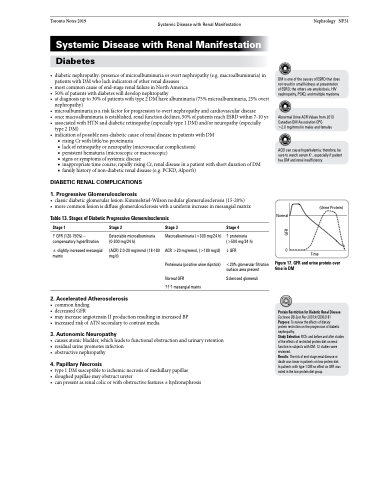Page 731 - TNFlipTest
P. 731
Toronto Notes 2019 Systemic Disease with Renal Manifestation Systemic Disease with Renal Manifestation
Diabetes
• diabeticnephropathy:presenceofmicroalbuminuriaorovertnephropathy(e.g.macroalbuminuria)in patients with DM who lack indicators of other renal diseases
• mostcommoncauseofend-stagerenalfailureinNorthAmerica
• 50% of patients with diabetes will develop nephropathy
• atdiagnosisupto30%ofpatientswithtype2DMhavealbuminuria(75%microalbuminuria,25%overt
nephropathy)
• microalbuminuriaisariskfactorforprogressiontoovertnephropathyandcardiovasculardisease
• once macroalbuminuria is established, renal function declines, 50% of patients reach ESRD within 7-10 yr
• associatedwithHTNanddiabeticretinopathy(especiallytype1DM)and/orneuropathy(especially
Nephrology NP31
DM is one of the causes of ESRD that does not result in small kidneys at presentation of ESRD; the others are amyloidosis, HIV nephropathy, PCKD, and multiple myeloma
Abnormal Urine ACR Values from 2013 Canadian DM Association CPG
>2.0 mg/mmol in males and females
ACEI can cause hyperkalemia; therefore, be
+ suretowatchserumK ,especiallyifpatient
has DM and renal insufficiency
type 2 DM)
• indicationofpossiblenon-diabeticcauseofrenaldiseaseinpatientswithDM
■ rising Cr with little/no proteinuria
■ lack of retinopathy or neuropathy (microvascular complications)
■ persistent hematuria (microscopic or macroscopic)
■ signs or symptoms of systemic disease
■ inappropriate time course; rapidly rising Cr, renal disease in a patient with short duration of DM ■ family history of non-diabetic renal disease (e.g. PCKD, Alport’s)
DIABETIC RENAL COMPLICATIONS
1 . Progressive Glomerulosclerosis
• classicdiabeticglomerularlesion:Kimmelstiel-Wilsonnodularglomerulosclerosis(15-20%)
• morecommonlesionisdiffuseglomerulosclerosiswithauniformincreaseinmesangialmatrix
(Urine Protein)
Time
Table 13. Stages of Diabetic Progressive Glomerulosclerosis
Normal
0
Stage 1
GFR (120-150%) – compensatory hyperfiltration
± slightly increased mesangial matrix
Stage 2
Detectable microalbuminuria (0-300 mg/24 h)
(ACR) 2.0-20 mg/mmol (18-180 mg/d)
Stage 3
Macroalbuminuria (>300 mg/24 h) ACR >20 mg/mmol, (>180 mg/d) Proteinuria (positive urine dipstick) Normal GFR
mesangial matrix
Stage 4
proteinuria (>500 mg/24 h)
GFR
<20% glomerular filtration
surface area present Sclerosed glomeruli
2 . Accelerated Atherosclerosis
Figure 17. GFR and urine protein over time in DM
Protein Restriction for Diabetic Renal Disease
Cochrane DB Syst Rev 2007;4:CD002181 Purpose: To review the effects of dietary protein restriction on the progression of diabetic nephropathy.
Study Selection: RCTs and before and after studies of the effects of restricted protein diet on renal function in subjects with DM. 12 studies were reviewed.
Results: The risk of end-stage renal disease or death was lower in patients on low-protein diet. In patients with type 1 DM no effect on GFR was noted in the low-protein diet group.
• commonfinding
• decreasedGFR
• mayincreaseangiotensinIIproductionresultinginincreasedBP • increasedriskofATNsecondarytocontrastmedia
3 . Autonomic Neuropathy
• causesatonicbladder,whichleadstofunctionalobstructionandurinaryretention • residualurinepromotesinfection
• obstructivenephropathy
4 . Papillary Necrosis
• type1DMsusceptibletoischemicnecrosisofmedullarypapillae
• sloughedpapillaemayobstructureter
• canpresentasrenalcolicorwithobstructivefeatures±hydronephrosis
GFR


